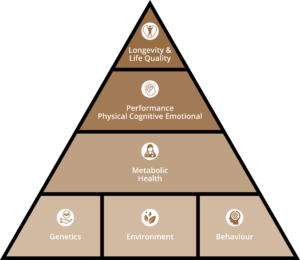The Longevity Framework provides both structure and flexibility to make highly personalised, precise and proactive changes to restore health.
I find getting older is a strange experience. When I talk to my patients I realise that a lot of us have the same experience. We may be “middle-aged”, or older, but in our heads, we still feel like we are in our twenties.
What makes us feel our age is when we start to notice a decline in our performance or health.
This could be things like getting out of breath going upstairs, being unable to lose the excess weight, joint aches, fatigue, forgetting things, losing physical strength, poor libido, or getting diagnosed with a health condition such as diabetes or high blood pressure.
When this happens, we tend to shrug our shoulders and put it down to “getting older”. It is “inevitable” so there is nothing that can be done about it.
However, having studied and worked in the health industry for over 2 decades, I no longer feel that the decline in our health and capabilities with age is unavoidable.
Based on my experience and the developments in medical science, I have designed a framework that helps me to identify specific actions the patient can make to restore their health and optimise their physical, cognitive and emotional fitness.
I call it the “Live Longer, Stronger Framework” because its purpose is to help increase lifespan and health span. It has a pyramid structure to emphasise how the function of each layer depends on the function of the one below.

The foundation on which this whole structure is built is made up of the 3 key components to health and fitness – genetics, environment and behaviour.
In medical science, the study of how these three factors interact is known as epigenetics.
Over the last 2 decades, there has been an exponential growth in the volume of research that supports the idea that assessing and adjusting someone’s genetics, environment, and behaviours can improve their health and fitness.
For example, studies have found that individuals with a specific genetic mutation had a higher risk of developing heart disease. However, when these individuals adopted healthy behaviours such as exercise, a healthy diet, and not smoking, their risk of heart disease was reduced.
An obvious environmental influence on health is air pollution. A study estimated that reducing air pollution to levels recommended by the World Health Organization could extend the average life expectancy of individuals by several months to a year.
While our genes certainly play a role in our health, it is not the only factor. Our environment and behaviours influence which genes are turned on or off, which in turn can impact our health and fitness.
The longevity framework allows me to communicate efficiently and effectively with my patients.
It ensures that we take an organised and holistic approach to their health problems.
The framework also allows us the flexibility to make highly personalised, precise and proactive changes to restore their health.
So, whether you’re a middle-aged man like me or someone looking to optimize your health and fitness at any age, the Live Longer, Stronger Framework can help you.
If you would like a copy of the longevity framework checklist I use for myself and my patients then please contact me.
Alternatively, you can book a video call and we can go through it together in real-time.
Dedicated to your longevity,
Dr Ben Ingram




